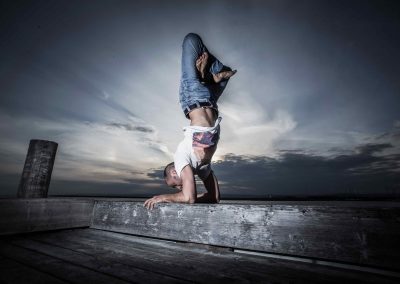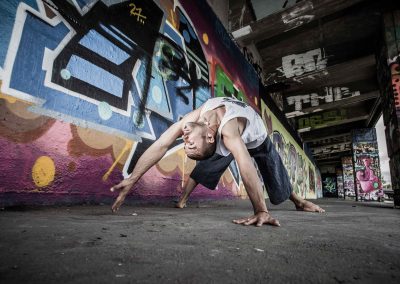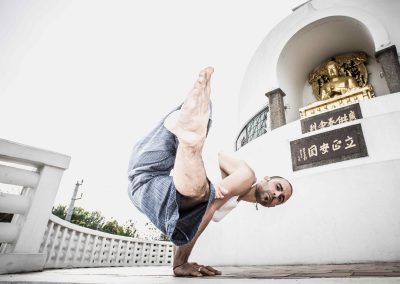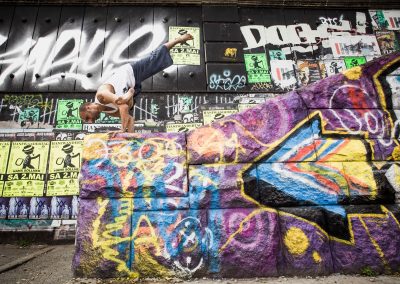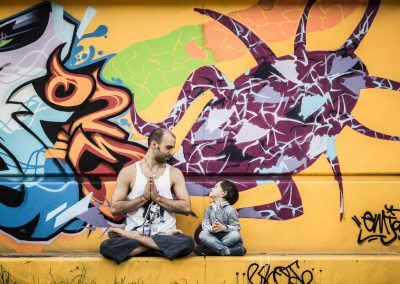Knut Rakus
MMag.
I experienced my first proper yoga session in 2003. It was in a basement in Jaisalmer, in the Indian state of Rajasthan and close to the border with Pakistan; I was dragged to a yoga class by my girlfriend at the time. The session was composed of static asanas, pranayama and chanting, and it was interesting because it was relatively “Indian” – it had nothing at all to do with colourful leggings, plastic mats, loud music and flowing movements.
It was followed by many years of up & down, irregularity and experimentation in my yoga practice. I followed the fairly typical path of a stressed pencil pusher plagued by back pain, sprinting through airports with a trolley and searching for some kind of balance because I just couldn’t do my job otherwise.
And so, in a variety of hotel rooms, I began to practise. In 2008, I had the opportunity to take one-on-one classes with a teacher on Wednesday of each week. That teacher was Axel Dinse, who at that time had just had his first two children. I practised under his guidance, with roaring, romping children all around me, under me, on top of me – just the way children are. I was rather confused, and thought to myself, “I’m coming here for yoga and I get this childish chaos!” But then I had to see that my practice developed hugely from precisely this chaos, and that yoga means being in the moment. If you can succeed in staying in the moment while two children bound about around you, then you can do it on your own. I also enjoyed being able to fall back on the fixed structure of Ashtanga yoga.
I’ve practised every day since and live much more consciously and in the moment than before. I wouldn’t like to say whether I’m a better person today than I was before I came across yoga: I have always loved life itself – but in the past, as a student, I pulled a few all-nighters and ate pasta with pesto by the bucketload, and that was wonderful, too.
What does yoga mean for you?
For me, yoga certainly doesn’t mean being able to bend your body into a pretzel. For me, yoga means moving through life in accordance with certain ideas and concepts. Asanas are one aspect of yoga, but many of the other aspects are ethical, action-based guidelines for existence: Asteya (non-stealing), Ahimsa (non-violence), Mitahara (eating in moderation), Sauca (cleanliness) and so on. I try to apply these yamas and niyamas (moral guidelines) from ancient texts and live them in my urban environment.
The majority of people who encounter yoga start with the physical aspect. That’s a good thing – here at Feelgoodstudio, we have the pleasure of helping students and witnessing truly unbelievable transformations! The spiritual aspect only comes with time, but even then it’s not something that happens for everyone – nor does it have to. Not everyone who kicks a football will one day play for Real Madrid. There are some people who would rather perform a few back exercises than undergo physiotherapy. If that means yoga, then great; if they do compensatory gymnastics, that’s just as good. In my experience, the idea that everything in yoga has to be made interesting for everyone simply isn’t realistic.
Which sessions do you teach at your Feelgoodstudio?
I teach sessions for beginner and advanced groups, so very different levels, and essentially everything except yoga for pregnant women. In one-on-one classes and private sessions, I meet people with physical and mental challenges that I can explore in detail. In this sense, one-on-one classes can sometimes be much more targeted than group sessions. I simply teach yoga and pass on what I am teaching to participants. Yoga is not a “one size fits all” concept: there is no one series and no one exercise that can suit all eight million people in Austria. And therein lies the art: offering group sessions full of options and variations. We place great importance on that here at Feelgoodstudio, as do I in my teaching.
What would you like your students to take away with them?
Julie and I set ourselves the aspiration of creating a place where people can feel well in and of themselves. And this is clear to see: when people come to see us in the studio at the end of the day, they are leaving happier than when they arrived; they’ve experienced themselves, they’ve sweated, but they smile happily – because they’ve worked for something. With us, everything is really relaxed and casual – you’re allowed to laugh, too. The central theme throughout the sessions is being in the moment. When I’m in the moment, I am completely neutral. I can’t feel unwell for psychological or psychological reasons in that moment, because I am fully present: if someone stands on one leg and shuts their eyes while also thinking that their hair looks stupid or that their toenails need cutting, they’ll fall over straight away. The asanas are designed to make it easier to be in the moment and to reinforce this.
Can you paint a picture of a group session with you as teacher?
In my sessions, we go through a sequence of exercises that will challenge you on a range of levels. You might learn how to stand up straight properly for the first time, or how to keep your balance standing on one leg. A lake of sweat might even form on the mat around you – but, sometimes, people suddenly realise what it really means to breathe. In today’s multi-tasking world, we are increasingly forgetting these things. In one-on-one classes, I frequently meet people from middle and top-level management positions who can send an email, handle two phone calls, prepare a PowerPoint presentation and look over an Excel file all at the same time – but are physically incapable of standing on one leg. Competitive and comparative elements have no place in my sessions – I want to offer you the opportunity to get to know yourself.

